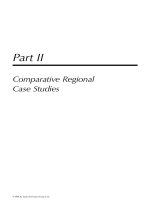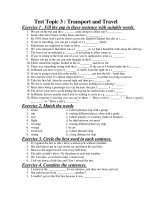Marketing management topic 3 analyzing business markets
Bạn đang xem bản rút gọn của tài liệu. Xem và tải ngay bản đầy đủ của tài liệu tại đây (189.28 KB, 21 trang )
MARKETING MANAGEMENT
Topic 3
Analyzing
Business Markets
Kotler
Keller
Chapter Questions
What is the business market, and how does it
differ from the consumer market?
What buying situations do organizational buyers
face?
Who participates in the business-to-business
buying process?
7-2
Chapter Questions
How do business buyers make their decisions?
How can companies build strong relationships
with business customers?
How do institutional buyers and government
agencies do their buying?
7-3
Organizational Buying
Decision-making process by which
formal organizations establish the
need for purchased products and
services, and identify
evaluate, and choose among
alternative brands and suppliers.
7-4
Characteristics of Business
Markets
Fewer, larger buyers
Close suppliercustomer relationships
Professional
purchasing
Many buying influences
Multiple sales calls
Derived demand
Inelastic demand
Fluctuating demand
Geographically
concentrated buyers
Direct purchasing
7-5
Buying Situation
Straight rebuy
Modified rebuy
New task
7-6
The Buying Center
Initiators
Users
Influencers
Deciders
Approvers
Buyers
Gatekeepers
7-7
Of Concern to Business Marketers
Who are the major decision participants?
What decisions do they influence?
What is their level of influence?
What evaluation criteria do they use?
7-8
Types of Business Customers
Price-oriented
Solution-oriented
Gold-standard
Strategic-value
7-9
Handling Price-Oriented Customers
Limit quantity purchased
Allow no refunds
Make no adjustments
Provide no services
7-10
Purchasing Orientations
Buying
Procurement
Supply chain management
7-11
Product-Related Purchasing Processes
Routine products
Leverage products
Strategic products
Bottleneck products
7-12
Methods of e-Procurement
Websites organized using vertical hubs
Websites organized using functional hubs
Direct extranet links to major suppliers
Buying alliances
Company buying sites
7-13
Forms of Electronic Marketplaces
Catalog sites
Vertical markets
Pure play auction sites
Spot markets
Private exchanges
Barter markets
Buying alliances
7-14
Assessing Customer Value
Internal engineering
assessment
Field value-in-use
assessment
Focus-group value
assessment
Direct survey
questions
Conjoint analysis
Benchmarks
Compositional
approach
Importance ratings
7-15
Order Routine Specification and
Inventory
Stockless purchase plans
Vendor-managed inventory
Continuous replenishment
7-16
Desirable Outcomes of a B2B
transaction: OTIFNE
On time
In full
No error
7-17
Establishing Corporate Credibility
Expertise
Trustworthiness
Likeability
7-18
Factors Affecting
Buyer-Supplier Relationships
Availability of alternatives
Importance of supply
Complexity of supply
Supply market dynamism
7-19
Categories of Buyer-Seller
Relationships
Basic buying and
selling
Bare bones
Contractual
transaction
Customer supply
Cooperative systems
Collaborative
Mutually adaptive
Customer is king
7-20
Opportunism
Some form of cheating or
undersupply relative to an
implicit or explicit contract.
7-21


![enterprise content management [electronic resource] a business and technical guide](https://media.store123doc.com/images/document/14/y/kd/medium_kdo1401468597.jpg)






